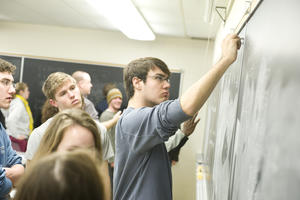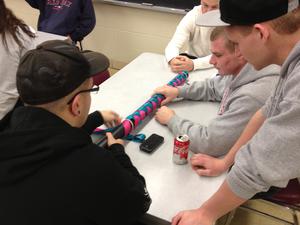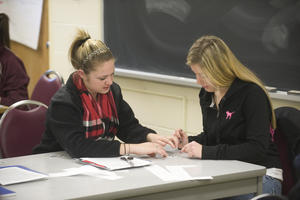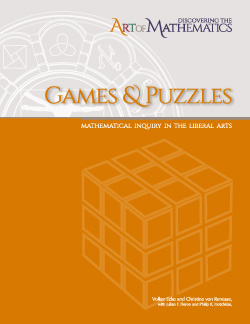How to Get Started
Written by: Dr. Julian Fleron
You’re ready to embrace inquiry-based learning (IBL) in your mathematics for liberal arts (MLA), or other general education courses, with the help of Discovering the Art of Mathematics (DAoM) materials. How do you get started?
There is one, singular issue that must guide you in all of your decisions in planning, all of your actions in the classroom, and all of your interactions with students:
As the teacher you must relinquish the role of the active mathematician to the students. The majority of class time should be spent with all students engaged in authentic mathematical experiences – experiences where they are in the central, active roles. Your role as teacher must be entirely redefined – from an authority who dispenses knowledge to a coach and cheerleader who supports students in their creation/discovery of knowledge.
We will remind you of this repeatedly, because this is the most critical step that is required in getting started.
"The goal of teaching is learning, not teaching." — Hugo Rossi
Making A Commitment to IBL
For teachers inexperienced with inquiry-based learning, choosing to teach in a very different way can be an intimidating experience. To reap the power and benefits of inquiry-based learning, it is important to commit fully to it for a meaningful period of time. Think of it as a teaching experiment. Even two committed weeks can be a transformative experience that helps inform all of your future teaching. But give yourself that opportunity – “I’m going to commit myself to trying this for one semester and then reassess” or “I’m going to do this one chapter, just like they suggest” or “I’m going to do one topic as a replacement unit and see how it goes.”
What this means is that your initial responsibility is to provide appropriate mathematical tasks, investigations, problems, and projects that actively engage your students in mathematical inquiry. Then you get out of the way and let them do mathematics. Of course, you support them in this inquiry – but this is likely a very different teacher role than you have experienced if you are new to IBL. We strongly recommend that you take this plunge at the beginning of the semester. Inquiry-based learning requires not only changes in the teacher’s role, but different norms for the students. If the first two-thirds of the course has a traditional structure and then you make a switch to inquiry-based learning, it is much less likely to be successful.
My first experience with inquiry-based learning in MLA was as a new Assistant Professor with no classroom experience in IBL, as a student or teacher. Excited, but overwhelmed with the wide-open opportunities for MLA – I had dreams of becoming a Carl Sagan figure for my students - my Department Chair handed me Harold Jacobs’ Mathematics: A Human Endeavor (whose structure is very much like DAoM books) and said, “Walk into class, given them this book and let the students’ work on these problem take over what happens in the classroom.” After teaching 50 sections of MLA in 20 years, I’m still amazed of the power of this approach – a collection of well-crafted problems/investigations/tasks for students to explore/solve/engage with - involving them in wonderful mathematical discovery.
We work to provide many resources for the use of IBL in MLA and other general education courses. But the starting point if you are new is simply to focus on getting started – putting things in the hands of the students.
“My job as a teacher is to make myself irrelevant.” — John Judge
Which Materials to Choose
Discovering the Art of Mathematics curriculum library has been designed specifically to provide curriculum resources to support inquiry-based learning in MLA. This material is ready to go, ready to form the basis of the guided student inquiry in your course.
It is up to you to choose which of this content you might use. There are 11 books in our series and many different ways they can be used:
- Choose One Book and Dive In – Each of our books provides materials that will more than fill a full-semester MLA course. I generally choose a single DAoM book and stick with it for much of the whole semester. I like to have the big, organizing themes that the books provide. If I have two sections, I generally use a different book in each section – I’m less likely to interfere in students’ inquiry if I am (re-)learning the material along with each class rather than immediately revisiting in my second class what just happened in my first.
- Mixing It Up – Half of the DAoM team find it helpful to switch things up as the semester progresses so they will choose a few chapters/topics from a few different DAoM books as course content. Many of the chapters in many of the books are independent from earlier chapters and can be used in modular ways. You may choose chapters by topic, perhaps to satisfy some guidelines or requirements for your course. The DAoM Topic Index provides a way to search for appropriate chapters with a given topic. This approach provides you with flexibility – as you see how things work and can better judge students response to the approach you can make decisions. You can also offer students opportunities to choose from among a range of possible topics to consider next.
- Pick One Chapter and Give It a Whirl – You may be hesitant to commit to a whole semester using a new pedagogy and curriculum. You may have limited space to include new topics as your course has required elements. As noted above, many of the chapters are independent of earlier chapters and the Topic Matrix can be useful if you are looking for certain content that might serve as a “replacement unit” for what you typically teach. If you are going to try a modular approach some chapters we might suggest include:
- "Other Puzzles: Kakuro, Radon/Kaczmarz, and What’s Inside of You” from Discovering the Art of Mathematics: Games and Puzzles
- "Straight Cut Origami” from Discovering the Art of Mathematics: Art and Sculpture
- "Tangles” from Discovering the Art of Mathematics: Knot Theory
- "Exploration of Rhythms and Pascal’s Triangle” from Discovering the Art of Mathematics: Music
- "The Use of Patterns and Language in the Creation of Powerful Number Systems” from Discovering the Art of Mathematics: Patterns
- "Existence of $\sqrt{-1}$: A Case Study” in Discovering the Art of Mathematics: Truth, Reasoning, Certainty and Proof
- Test Drive a Single Topic – You may just want to try out a smaller topic to help get a sense of what this style of teaching is like before making decisions about what materials to try for longer sections of a course. The chapter “Proof” from the upcoming Discovering the Art of Mathematics – Student Toolbox has many nice topics (
 Student Toolbox Box, Chapter on Proof). These include:
Student Toolbox Box, Chapter on Proof). These include:
- Finger Man – Can be done in part of a single class.
- Casting Out Nines – Usually takes significant parts of two classes and student work outside of class time.
- The Human Calculator – Takes a significant part of one class. Self-contained and students can be asked to perform the trick afterwards for assessment purposes. (See the video “Human Calculator Trick” to see the trick in action and one way to perform it in the classroom.)
- 3a+5b Problem – Takes significant portions of several classes. (See the blog on $3a + 5b$ Proofs.)
- Pythagorean Theorem – Takes about one class.
- Galileo Sums and Galileo Fractions – Take about one class.
- Pennies and Paperclips – Takes one class and part of another. The role of conjectures, refutations and proofs is quite rich and the opportunities for written solutions are excellent; see the blog on Pennies & Paperclips Proofs.
This chapter and accompanying teacher notes are available at
![]() Student Toolbox Box, Chapter on Proof
Student Toolbox Box, Chapter on Proof
Your enthusiasm and interest is important, it is important that you choose topics that you find compelling. If you have any questions or concerns about which topics may be appropriate for you or if you are having trouble locating things, please be certain to contact us.
“I am convinced that most of you will discover from your [reflection on]… those moments of learning that really mattered to you, no teacher was behaving like the brilliant lecturer of my earlier portrait. If a teacher or teacher-like figure was important to your learning, she was probably doing something different from enthusiastic Telling.” — Donald L. Finkel, p. 7 from the book Teaching with Your Mouth Shut
Getting Ready
Students must become actively involved in mathematical inquiry right away. If this is to be the major activity of the course, the tone needs to be set early – preferably on day one. What do you need to do?
First, prior to the beginning of the semester, practice being a student in your course. Sit down with the material you are going to begin with. Work through a section of investigations as you envision your students doing – perhaps in a group (recruit an interested friend or colleague or two – especially good are non-mathematicians as that is what your course will be made up of), writing answers in a notebook if that’s what you will require them to do, verbally communicating solutions to specific investigations if you will require that, etc. Likely this will feel much like doing mathematics generally does to you. But remember, what it normally feels like to be a student in a mathematics class is to sit passively and watch an expert do mathematics before going home to conquer a list of homework problems that seem decidedly more challenging than what was transmitted to you in class! Practicing with the materials will help you envision what you ask of your students and also provide a first model for you – this is what my students should be doing when our course starts.
But don’t prep too much. You should know and understand the mathematics that will be considered. But you should not script things as you would when prepping for a finely polished lecture. Students will approach the investigations in ways that are different than you expect – in fact different in ways that you could expect – and if you program things too much your perspectives will overshadow the students’ own unique approaches. You are there to support the students in their journey of discovery.
“Mathematics is something one does.” — E.E. Moise
What Material To Give the Students
If you give each student a bound copy of the DAoM book you’ll use for the course on the first day they are excited not to have to pay $200 for a textbook. (You can have these copied at your school’s copy center. If the cost of copying should be covered by the students, you can have them copied and then sold for cost through the bookstore.) They have something in hand that is substantial and looks very official. Students will have the entire book and access to things that may not be covered in class if they have interest in exploring more.
Of course, because the book is available electronically, students can download an electronic copy. As the material is fundamental to the day-to-day classroom work, we’ve had the most luck when students also have some sort of printed version available to them in class.
Typically we distribute DAoM materials to students in smaller packets – often a chapter or even a section at a time. Sometimes this is done for flexibility. More often it is done for pacing. Materials are typified by a long sequence of carefully crafted investigations. Students sometimes begin to see the materials as “worksheets” and their goal is to “complete” these problems. Completion of individual prompts is not the goal. Rather the goal is sense-making - understanding of the mathematical topic that is the focus of each section or chapter. The goal is not just disjointed “answers”, but synthesis and accommodation through classroom discussions, crafting final write-ups, solution stories, proofs, etc.
I generally bring in a bound copy of the entire book that we will be using, show it to the students, and explain that it is free. Then I hand out the first chapter of the book. I hand it out in its entirety and immediately have the students jump right to the investigations with little or no introduction. If there are definitions or introductory comments that they need from the initial text in the chapter, they go back to find what they need. As homework I have the class read the textual portions of the chapter that precede the investigations and we discuss it in the next class – taking only the first five minutes or so to do this. We then pick up with the investigations where we left off. In typical 50 minute classes, 40 minutes are spent with students working cooperatively in groups. Every few days I indicate how far I think students should have progressed.
There are also a number of more self-contained topics that are described in our blog “The First Day of the Semester: Good Activities” that can be used for the first few classes for you and your students to get acclimated.
Some of our group prefers to focus on bigger questions from the outset, when possible, giving the written material only after the students have had some time to explore on their own. So, for example, many of the topics listed above from the Student Toolbox can be done without giving the students any written material – they are easily posed and the students need essentially no guidance to get started.
All of these decisions are part of the experiment. Experiment by trying different approaches to how you distribute the materials to your students – see what works best for you and for your students.
“We only think when confronted by a problem.”
Then What?
We have focused on getting mathematics in students hands and getting them actively working. After all, that is the focus of IBL. There are many other things that go into teaching a successful course using IBL. We have explored some of them in previous blogs, like setting the stage, assessment and syllabi, learning contracts, our IBL classroom, asking good questions,… . We will explore others in future blogs and hope to include: pacing, “IBL fatigue”, working in groups, and expectations of students outside of class. If you have a suggestion for something you find particularly difficult, please feel free to suggest it!
We continue to post additional classroom videos, please check on our Media Page and click on the "Videos" tab. We hope that these are of value in modeling potential classroom structures.
Lots of things go into a success course, IBL or otherwise. But remember, in an IBL classroom, none of these things are as important as the main goal – to entrust students with real mathematical explorations.
We wish you wonderful mathematical adventures with your students! If we can help, please do not hesitate to contact us.





